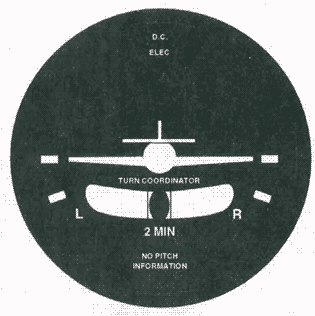FAAの筆記試験(Knowledge Exam)について。 : Privateの筆記試験について : PVTの問題へ : IFR、筆記の解説 : IFR問題へ
Private Pilot : 2007年 Airman Knowledge Test Question (Written Exam)
61.
During flight, when are the indications of a magnetic compass accurate?
A) Only in straight-and-level unaccelerated flight.
B) As long as the airspeed is constant.
C) During turns if the bank does not exceed 18°.
私流の和訳 : 説明ページ
62.
In the Northern Hemisphere, the magnetic compass will normally indicate a turn toward the south when
A) a left turn is entered from an east heading.
B) a right turn is entered from a west heading.
C) the aircraft is decelerated while on a west heading.
私流の和訳 : 説明ページ
63.
(Refer to figure 5.) A turn coordinator provides an indication of the
A) movement of the aircraft about the yaw and roll axis.
B) angle of bank up to but not exceeding 30°.
C) attitude of the aircraft with reference to the longitudinal axis.

Figure 5
64.
If the pitot tube and outside static vents become clogged, which instruments would be affected?
A) The altimeter, airspeed indicator, and turn-and-slip indicator.
B) The altimeter, airspeed indicator, and vertical speed indicator.
C) The altimeter, attitude indicator, and turn-and-slip indicator.
65.
The presence of carburetor ice in an aircraft equipped with a fixed-pitch propeller can be verified by applying carburetor heat and noting
A) an increase in RPM and then a gradual decrease in RPM.
B) a decrease in RPM and then a constant RPM indication.
C) a decrease in RPM and then a gradual increase in RPM.
66.
With regard to carburetor ice, float-type carburetor systems in comparison to fuel injection systems are generally considered to be
A) more susceptible to icing.
B) equally susceptible to icing.
C) susceptible to icing only when visible moisture is present.
67.
Which condition is most favorable to the development of carburetor icing?
A) Any temperature below freezing and a relative humidity of less than 50 percent.
B) Temperature between 32 and 50 °F and low humidity.
C) Temperature between 20 and 70 °F and high humidity.
68.
The operating principle of float-type carburetors is based on the
A) automatic metering of air at the venturi as the aircraft gains altitude.
B) difference in air pressure at the venturi throat and the air inlet.
C) increase in air velocity in the throat of a venturi causing an increase in air pressure.
69.
While cruising at 9,500 feet MSL, the fuel/air mixture is properly adjusted. What will occur if a descent to 4,500 feet MSL is made without readjusting the mixture?
A) The fuel/air mixture may become excessively lean.
B) There will be more fuel in the cylinders than is needed for normal combustion, and the excess fuel will absorb heat and cool the engine.
C) The excessively rich mixture will create higher cylinder head temperatures and may cause detonation.
70.
Generally speaking, the use of carburetor heat tends to
A) decrease engine performance.
B) increase engine performance.
C) have no effect on engine performance.
Private Pilot Knowledge Test (Private Written Exam) 05/23/2007 :
2008年の問題へ